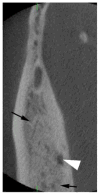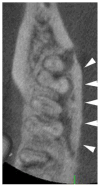Stage 0 osteonecrosis of the jaw in a patient on denosumab
- PMID: 24397946
- PMCID: PMC4045108
- DOI: 10.1016/j.joms.2013.09.008
Stage 0 osteonecrosis of the jaw in a patient on denosumab
Abstract
Osteonecrosis of the jaws (ONJ) is a complex disease involving multiple tissue and cell-type responses to wound healing or infection. AAOMS defines bisphosphonate related ONJ (BRONJ) as exposed, necrotic bone in the maxillofacial region that has persisted for more than 8 weeks in a patient with current or previous antiresorptive treatment, without a history of radiation therapy to the jaws. Since the first reported ONJ cases in 2003 and 2004, there has been little advancement in understanding the etiology and pathophysiology of ONJ. Many hypotheses have been proposed, including bisphosphonate (BP) toxicity to oral epithelium, altered wound healing after tooth extraction, high turnover of the mandible and maxilla, oral biofilm formation, infection and inflammation, and suppression of angiogenesis and bone turnover. The current classification system of ONJ involves stages 0 to 3 and is based on patient clinical presentation. This report describes a case of stage 0 ONJ in a patient on denosumab and indicates the full-spectrum similarities between BP- and denosumab-associated ONJ clinically, radiographically, and histologically.
Published by Elsevier Inc.
Figures
















Similar articles
-
Denosumab and osteonecrosis of the jaws - the pharmacology, pathogenesis and a report of two cases.Aust Dent J. 2014 Dec;59(4):516-9. doi: 10.1111/adj.12217. Epub 2014 Sep 27. Aust Dent J. 2014. PMID: 25131835
-
Denosumab-associated osteonecrosis of the jaw--a case report.Dent Update. 2014 Jun;41(5):449-50. doi: 10.12968/denu.2014.41.5.449. Dent Update. 2014. PMID: 25073227
-
Denosumab-related osteonecrosis of the jaw.J Am Dent Assoc. 2012 Sep;143(9):981-4. doi: 10.14219/jada.archive.2012.0323. J Am Dent Assoc. 2012. PMID: 22942143
-
Antiresorptive drug-related osteonecrosis of the jaw.Dent Clin North Am. 2014 Apr;58(2):369-84. doi: 10.1016/j.cden.2013.12.006. Dent Clin North Am. 2014. PMID: 24655528 Review.
-
Denosumab and anti-angiogenetic drug-related osteonecrosis of the jaw: an uncommon but potentially severe disease.Anticancer Res. 2013 May;33(5):1793-7. Anticancer Res. 2013. PMID: 23645723 Review.
Cited by
-
Gnathodiaphyseal dysplasia: report of a family with a novel mutation of the ANO5 gene.Oral Surg Oral Med Oral Pathol Oral Radiol. 2016 May;121(5):e123-8. doi: 10.1016/j.oooo.2016.01.014. Epub 2016 Jan 28. Oral Surg Oral Med Oral Pathol Oral Radiol. 2016. PMID: 27068316 Free PMC article.
-
Osteonecrosis of the Jaw.Dent J (Basel). 2023 Jan 9;11(1):23. doi: 10.3390/dj11010023. Dent J (Basel). 2023. PMID: 36661560 Free PMC article. Review.
-
Three-dimensional clinical assessment for MRONJ risk in oncologic patients following tooth extractions.Dentomaxillofac Radiol. 2023 Nov;52(8):20230238. doi: 10.1259/dmfr.20230238. Epub 2023 Oct 24. Dentomaxillofac Radiol. 2023. PMID: 37874081 Free PMC article.
-
Osteonecrosis of the Jaw in the Absence of Antiresorptive or Antiangiogenic Exposure: A Series of 6 Cases.J Oral Maxillofac Surg. 2017 Jan;75(1):129-142. doi: 10.1016/j.joms.2016.07.019. Epub 2016 Jul 30. J Oral Maxillofac Surg. 2017. PMID: 27569557 Free PMC article.
-
Histopathological significance of necrosis in oral lesions: A review.J Oral Maxillofac Pathol. 2023 Apr-Jun;27(2):340-347. doi: 10.4103/jomfp.jomfp_39_23. Epub 2023 Jul 13. J Oral Maxillofac Pathol. 2023. PMID: 37854904 Free PMC article. Review.
References
-
- Farah CS, Savage NW. Oral ulceration with bone sequestration. Aust Dent J. 2003;48:61. - PubMed
-
- Meer S, Coleman H, Altini M, Alexander T. Mandibular osteomyelitis and tooth exfoliation following zoster-CMV co-infection. Oral Surg Oral Med Oral Pathol Oral Radiol Endod. 2006;101:70. - PubMed
-
- Schwartz HC. Osteonecrosis of the jaws: a complication of cancer chemotherapy. Head Neck Surg. 1982;4:251. - PubMed
-
- Advisory Task Force on Bisphosphonate-Related Ostenonecrosis of the Jaws AAoO, Maxillofacial S American Association of Oral and Maxillofacial Surgeons position paper on bisphosphonate-related osteonecrosis of the jaws. J Oral Maxillofac Surg. 2007;65:369. - PubMed
-
- Ruggiero SL, Dodson TB, Assael LA, Landesberg R, Marx RE, Mehrotra B American Association of O Maxillofacial S. American Association of Oral and Maxillofacial Surgeons position paper on bisphosphonate-related osteonecrosis of the jaws--2009 update. J Oral Maxillofac Surg. 2009;67:2. - PubMed
Publication types
MeSH terms
Substances
Grants and funding
LinkOut - more resources
Full Text Sources
Other Literature Sources
Medical

